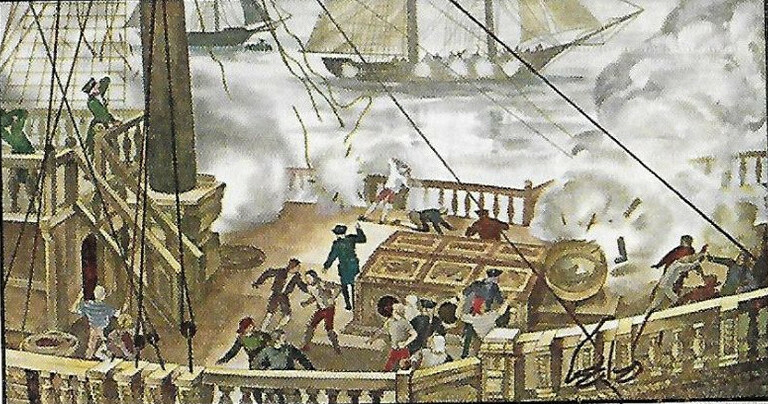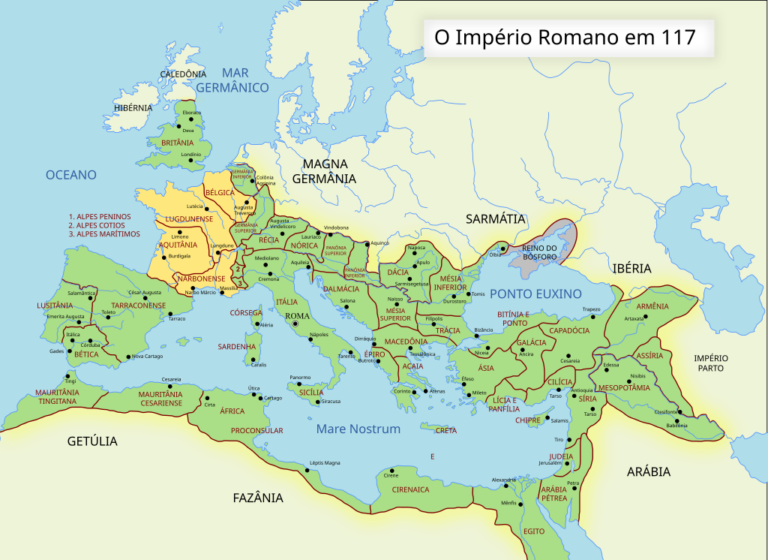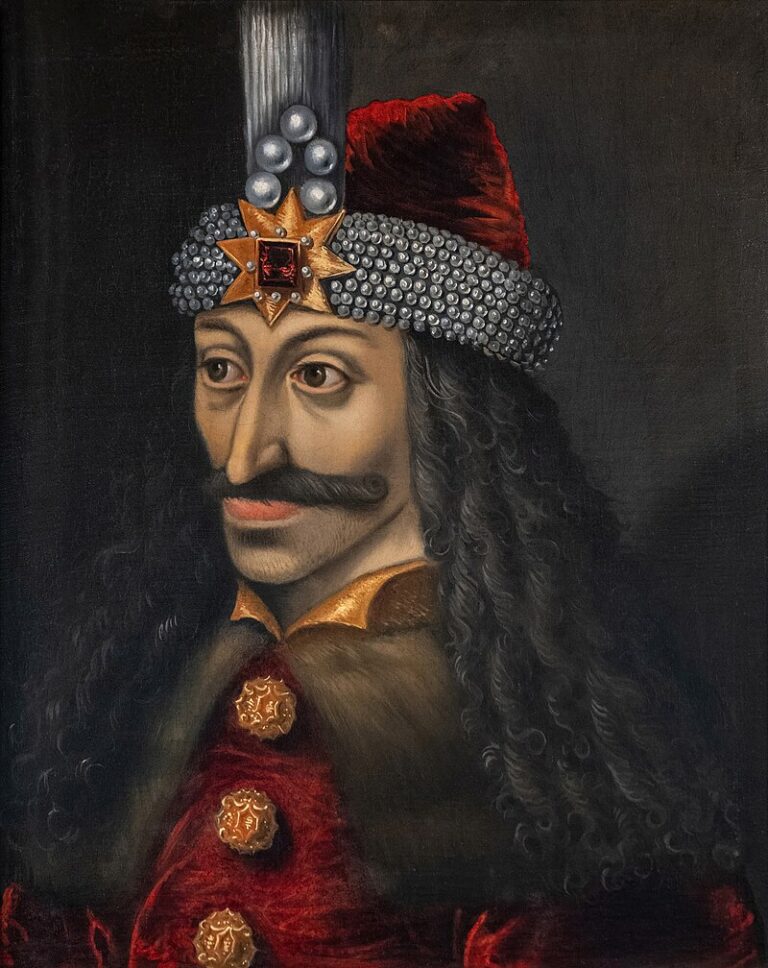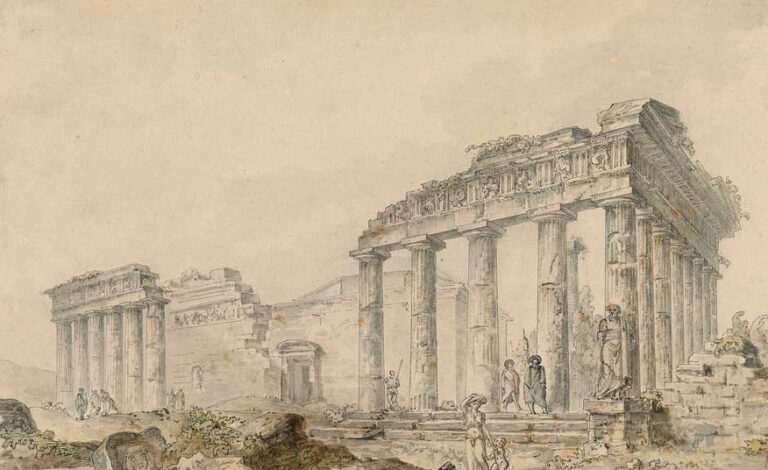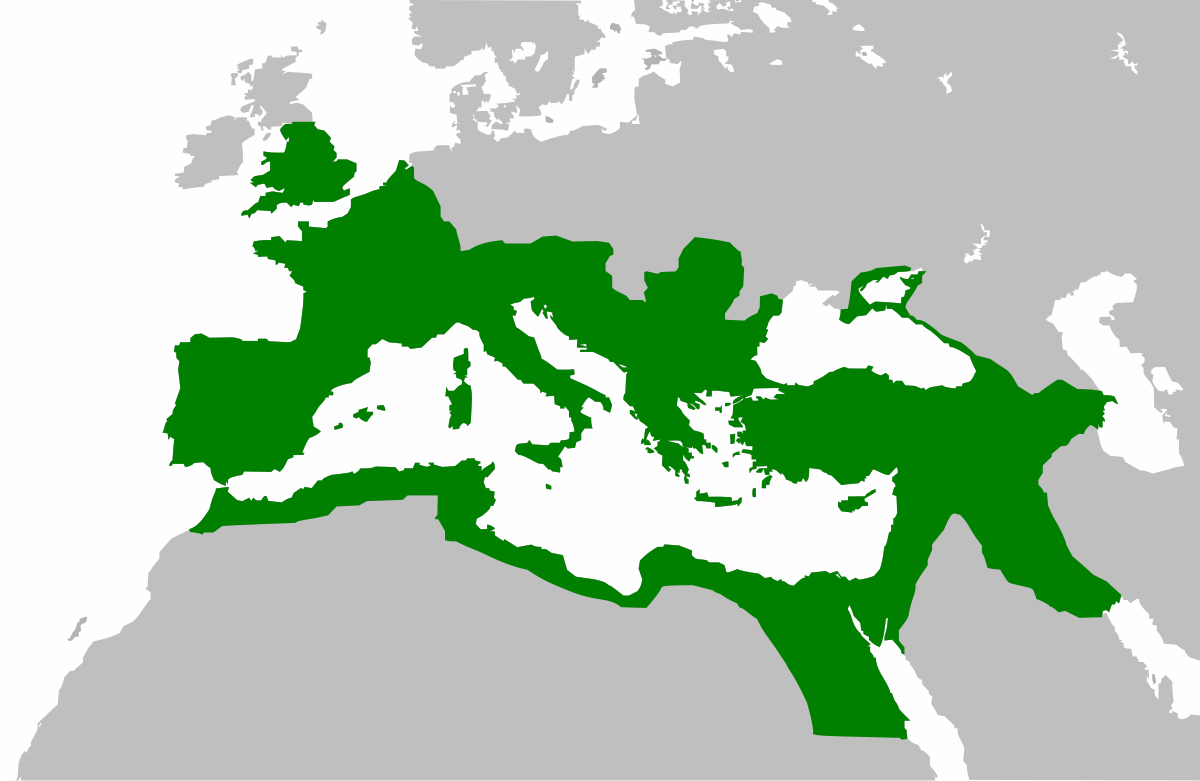
The rise and fall of Rome is a remarkable story. From its humble beginnings as a small city-state in central Italy, Rome expanded into one of the greatest empires in history, controlling vast territories across Europe, North Africa, and the Middle East. However, Rome’s expansion was not limitless, and over time, internal instability, economic struggles, and external pressures led to its gradual fragmentation and decline.
This article divides Roman history into key periods based on its territorial expansion and contraction, tracing the transformation from a regional power to a global empire and, finally, its fragmentation into the Eastern and Western Roman Empires.
1. Early Rome and Local Consolidation (753–338 BCE)
Rome’s earliest history was marked by gradual territorial expansion from a small settlement on the Tiber River into the dominant power of central Italy. According to legend, Rome was founded in 753 BCE by Romulus, and for its first two centuries, it was ruled by kings. During this period, the city expanded its influence over neighboring Latin, Sabine, and Etruscan communities through warfare, alliances, and political integration. The transition from monarchy to republic around 509 BCE set the stage for further territorial growth, as Rome engaged in conflicts with the Etruscans, Volsci, and Aequi.
By 338 BCE, after the Latin War, Rome had firmly established control over Latium, incorporating many former Latin allies into its growing sphere of influence. The city itself had expanded its direct control to include key towns such as Tibur (modern Tivoli), Praeneste (modern Palestrina), and Antium (modern Anzio). Additionally, Roman influence extended beyond Latium into parts of southern Etruria, the Sabine and Volscian territories, and sections of Campania, including the strategically significant city of Capua. At this stage, Rome controlled an area roughly 20,000 square kilometers (7,700 square miles)—a significant portion of central Italy.
2. Expansion of the Roman Republic (338–27 BCE)
Following its victory in the Latin War (338 BCE), Rome embarked on a period of rapid territorial expansion that transformed it from a dominant regional power in central Italy into the unchallenged ruler of the Mediterranean world. This era saw Rome extend its control over the entire Italian Peninsula before engaging in a series of wars that brought it into direct conflict with powerful foreign empires such as Carthage, Macedonia, and the Hellenistic kingdoms.
Conquest of Italy (338–272 BCE)
After subjugating Latium, Rome turned its attention to central and southern Italy. The Samnite Wars (343–290 BCE) resulted in the defeat of the warlike Samnites, granting Rome dominance over much of central Italy. The victory in the Pyrrhic War (280–275 BCE) against the Greek city-states of southern Italy, including the wealthy colony of Tarentum, solidified Roman rule over the entire peninsula. By 272 BCE, Rome directly or indirectly controlled most of Italy, either through colonies, alliances, or direct governance.
Wars of Mediterranean Expansion (264–146 BCE)
With Italy secured, Rome’s ambitions extended beyond the peninsula. The Punic Wars (264–146 BCE) against Carthage were a turning point, as Rome emerged victorious in a series of brutal conflicts. The First Punic War (264–241 BCE) gave Rome control over Sicily, its first overseas province. The Second Punic War (218–201 BCE), famous for Hannibal’s invasion of Italy, ended with Rome gaining Spain and North Africa. Finally, the Third Punic War (149–146 BCE) resulted in the complete destruction of Carthage, making North Africa a Roman province.
During this period, Rome also expanded into the eastern Mediterranean. The Macedonian Wars (214–148 BCE) saw the defeat of Macedonia and the incorporation of Greece as a Roman protectorate. In 133 BCE, Pergamon (in modern Turkey) was bequeathed to Rome, marking its first territorial acquisition in Asia. By the mid-2nd century BCE, Rome had become the supreme power of the Mediterranean world, controlling territories in Italy, Spain, North Africa, Greece, and parts of Asia Minor.
Final Republican Conquests and Internal Struggles (133–27 BCE)
Despite its military successes, Rome faced increasing internal turmoil as vast conquests created economic inequality and political instability. Nevertheless, expansion continued. The campaigns of Julius Caesar (58–50 BCE) resulted in the conquest of Gaul (modern France, Belgium, and parts of Germany and Switzerland), significantly increasing Rome’s territorial reach in Europe. Meanwhile, Rome’s involvement in Egypt intensified, culminating in Octavian’s victory over Mark Antony and Cleopatra in 30 BCE, making Egypt a Roman province.
By the time Octavian (later Augustus) declared the end of the Republic in 27 BCE, Rome had established an empire stretching from the Atlantic Ocean in the west to the Euphrates River in the east, and from the British Channel in the north to the Sahara in the south. This period of rapid expansion had made Rome the most powerful state of the ancient world, but it also set the stage for the transition from a republic to an imperial system, as managing such vast territories required centralized authority.
3. The Roman Empire at Its Height (27 BCE – 180 CE)
With the transition from republic to empire in 27 BCE, Rome entered its greatest period of territorial expansion and stability. Under the rule of Augustus and his successors, the empire extended its borders to their maximum, covering vast territories across Europe, North Africa, and the Middle East. This era, often referred to as the Pax Romana (Roman Peace), saw both military conquests and a consolidation of Roman rule, ensuring administrative efficiency, economic prosperity, and relative peace across the empire.
Augustan Expansion and the Foundations of Empire (27 BCE – 14 CE)
The first emperor, Augustus (27 BCE – 14 CE), focused on securing and stabilizing Rome’s frontiers. He completed the conquest of Spain, subjugated the Alpine tribes, and expanded Roman control into Illyria and Pannonia (modern Balkans). He also established Egypt as a Roman province following the defeat of Mark Antony and Cleopatra, securing control over the grain supply crucial for Rome’s population.
However, attempts to expand further into Germania ended in disaster when the Roman legions suffered a crushing defeat at the Battle of Teutoburg Forest (9 CE). This marked the Rhine River as the effective northern frontier of the empire, limiting further expansion into Germanic lands.
The Flavian and Trajanic Conquests (69–117 CE)
After the chaotic Year of the Four Emperors (69 CE), the Flavian dynasty (69–96 CE) continued Rome’s expansion, notably in Britain, where Emperor Claudius had initiated conquest in 43 CE. The province was gradually Romanized, with major centers like Londinium (modern London) emerging. However, resistance remained, as seen in Boudica’s revolt (60–61 CE).
The empire reached its greatest territorial extent under Emperor Trajan (98–117 CE), whose conquests pushed Rome beyond its earlier limits.
- Dacia (modern Romania) was annexed in 106 CE, following successful campaigns against the Dacians.
- The Nabataean Kingdom (modern Jordan and parts of Arabia) was incorporated in 106 CE, forming the province of Arabia Petraea.
- The Parthian War (113–117 CE) briefly extended Roman rule into Mesopotamia (modern Iraq), including Babylon and Ctesiphon, but these gains proved unsustainable.
By 117 CE, at the end of Trajan’s reign, the Roman Empire spanned an estimated 5 million square kilometers (1.9 million square miles), stretching from Britain to the Euphrates, and from the Atlantic to the Sahara. It was the largest empire the Mediterranean world had ever seen.
Hadrian’s Defensive Strategy and the Stability of the Pax Romana (117–180 CE)
Unlike his predecessor, Emperor Hadrian (117–138 CE) focused on consolidating rather than expanding Rome’s borders. He withdrew from Mesopotamia, recognizing its difficulty to defend, and instead reinforced existing frontiers with fortifications like Hadrian’s Wall (122 CE) in Britain. Similarly, defensive lines such as the Limes Germanicus were built along the Rhine and Danube Rivers to protect against Germanic and Sarmatian tribes.
For much of the 2nd century CE, Rome enjoyed relative peace and stability, known as the Pax Romana. Trade flourished across the Mediterranean, roads and infrastructure connected distant provinces, and Roman culture spread widely. The empire functioned efficiently under rulers like Antoninus Pius (138–161 CE) and Marcus Aurelius (161–180 CE), though the latter faced increasing pressure from external invasions, particularly from Germanic and Parthian forces.
4. Stagnation and Contraction of the Roman Empire (180–476 CE)
By the end of the 2nd century CE, the Roman Empire had reached its maximum territorial extent and was beginning to struggle with maintaining control over its vast domain. The period from 180 CE to 476 CE was marked by internal instability, economic crises, plagues, political corruption, and increasing pressure from external enemies. Rome gradually transitioned from a unified empire into two separate entities—the Western and Eastern Roman Empires—before the collapse of the Western Roman Empire in 476 CE.
The Crisis of the Third Century (235–284 CE)
Following the assassination of Emperor Commodus in 192 CE, Rome entered a period of political instability known as the Severan Dynasty (193–235 CE). While emperors like Septimius Severus (193–211 CE) managed to maintain the empire’s borders, his successors struggled to control both the military and the economy.
In 235 CE, the murder of Emperor Alexander Severus triggered the Crisis of the Third Century (235–284 CE), during which Rome suffered from:
- Frequent civil wars: More than 26 emperors ruled in just 50 years, many assassinated by their own soldiers.
- Economic decline: Heavy taxation, currency devaluation, and inflation weakened the economy.
- Plague and famine: Disease outbreaks devastated the population.
- Foreign invasions: The Sassanid Empire (Persia) invaded the eastern provinces, while Germanic tribes such as the Goths and Alamanni raided the northern borders.
- Breakaway empires: The Roman Empire temporarily split into three rival states—the Gallic Empire (in Gaul and Britain), the Palmyrene Empire (in the East), and the central Roman Empire.
Despite these challenges, the empire was reunited under Emperor Aurelian (270–275 CE), who reconquered the breakaway territories. However, the empire remained fragile until Emperor Diocletian (284–305 CE) enacted reforms to restore order.
The Division of the Empire and the Rise of the Eastern Roman Empire (284–337 CE)
Realizing that the empire had become too large to govern effectively, Diocletian (r. 284–305 CE) divided it into the Western and Eastern Roman Empires in 285 CE, with separate rulers for each half. He also:
- Strengthened the military to defend against invasions.
- Introduced economic reforms to stabilize the currency.
- Created the Tetrarchy (rule by four emperors) to share power and reduce internal conflict.
Although Diocletian’s reforms temporarily stabilized the empire, they failed to prevent future divisions. Constantine the Great (r. 306–337 CE) reunified the empire but moved the capital from Rome to Byzantium (renamed Constantinople) in 330 CE, shifting power towards the wealthier eastern provinces.
The Decline and Fall of the Western Roman Empire (337–476 CE)
Following Constantine’s death, the empire was divided again, with the Eastern Roman Empire (Byzantium) remaining strong, while the Western Roman Empire weakened. A series of Germanic invasions accelerated the collapse of the West:
- Battle of Adrianople (378 CE): The Visigoths defeated the Roman army, killing Emperor Valens and exposing the empire’s vulnerability.
- Sack of Rome (410 CE): The Visigoths, led by Alaric I, looted Rome, shocking the empire.
- Loss of provinces:
- Britain was abandoned (410 CE).
- Spain and North Africa fell to the Vandals.
- Gaul and Italy faced repeated invasions.
- Final collapse (476 CE): The last Western Roman Emperor, Romulus Augustulus, was deposed by the Germanic chieftain Odoacer, marking the official fall of the Western Roman Empire.
The Eastern Roman Empire Survives
While the Western Empire crumbled, the Eastern Roman Empire (Byzantine Empire) continued to thrive, preserving Roman laws, culture, and traditions for another thousand years until the fall of Constantinople in 1453.
This period marked the end of Rome as a unified empire, signaling the transition from Antiquity to the Middle Ages, with Germanic kingdoms emerging in the former Western territories while the Byzantine Empire carried on Rome’s legacy in the East.
…
Cover image: Angelus, CC BY-SA 3.0 http://creativecommons.org/licenses/by-sa/3.0/, via Wikimedia Commons
Related articles: Periodization of the Roman Senate

